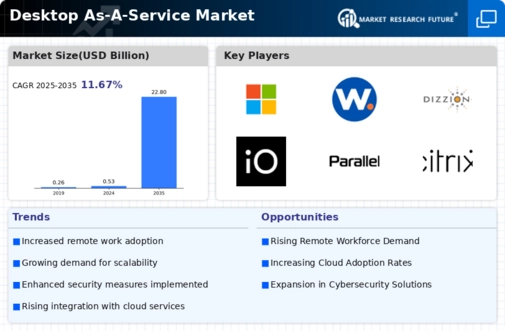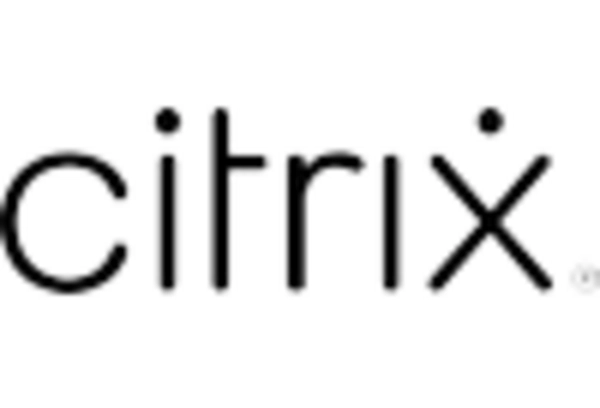Enhanced Scalability and Flexibility
Scalability and flexibility are increasingly recognized as vital components of the Desktop As-A-Service Market. Organizations are often faced with fluctuating workforce sizes and varying project demands, necessitating a desktop solution that can adapt accordingly. DaaS provides the ability to quickly scale up or down based on user requirements, allowing businesses to respond to changing market conditions with agility. This adaptability is particularly beneficial for companies experiencing rapid growth or seasonal fluctuations. Furthermore, the Desktop As-A-Service Market enables organizations to provision new desktops in a matter of minutes, streamlining the onboarding process for new employees. This level of flexibility is becoming a key differentiator in a competitive landscape.
Integration of Advanced Technologies
The integration of advanced technologies is a driving force within the Desktop As-A-Service Market. As organizations seek to enhance their operational capabilities, the incorporation of technologies such as artificial intelligence and machine learning into DaaS solutions is becoming increasingly prevalent. These technologies can optimize resource allocation, improve user experience, and automate routine tasks, thereby increasing overall productivity. Furthermore, the Desktop As-A-Service Market is witnessing a trend towards the incorporation of analytics tools that provide insights into user behavior and system performance. This data-driven approach enables organizations to make informed decisions regarding their IT strategies, ultimately leading to improved efficiency and effectiveness in their operations.
Focus on Data Security and Compliance
Data security and compliance are paramount concerns for organizations utilizing the Desktop As-A-Service Market. As cyber threats continue to evolve, businesses are prioritizing solutions that offer robust security measures. DaaS providers typically implement advanced security protocols, including encryption, multi-factor authentication, and regular security updates. This focus on security not only protects sensitive information but also aids in compliance with various regulatory requirements. Recent studies suggest that organizations utilizing DaaS can enhance their security posture significantly compared to traditional desktop environments. Consequently, the Desktop As-A-Service Market is likely to thrive as companies seek to mitigate risks associated with data breaches and ensure compliance with industry standards.
Rising Demand for Remote Work Solutions
The Desktop As-A-Service Market is experiencing a notable surge in demand for remote work solutions. As organizations increasingly adopt flexible work arrangements, the need for reliable and scalable desktop services has become paramount. According to recent data, the market is projected to grow at a compound annual growth rate of approximately 25% over the next five years. This growth is driven by the necessity for employees to access corporate resources securely from various locations. Furthermore, businesses are recognizing the cost-effectiveness of DaaS solutions, which eliminate the need for extensive on-premises infrastructure. Consequently, the Desktop As-A-Service Market is positioned to benefit from this trend, as companies seek to enhance productivity while maintaining operational efficiency.
Cost Efficiency and Resource Optimization
Cost efficiency remains a critical driver within the Desktop As-A-Service Market. Organizations are increasingly seeking ways to optimize their IT expenditures, and DaaS solutions offer a compelling alternative to traditional desktop environments. By leveraging cloud-based services, companies can reduce hardware costs, maintenance expenses, and energy consumption. Recent analyses indicate that businesses can save up to 30% on IT costs by transitioning to DaaS. This financial incentive is particularly appealing for small to medium-sized enterprises that may lack the resources for extensive IT infrastructure. As a result, the Desktop As-A-Service Market is likely to see continued growth as more organizations recognize the potential for significant cost savings and improved resource allocation.


















Leave a Comment